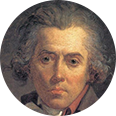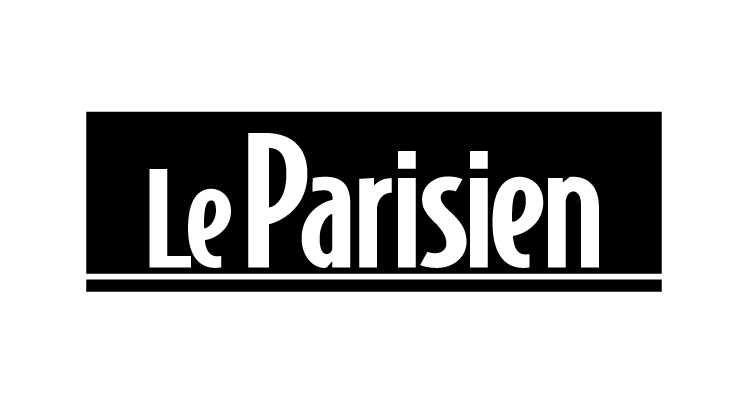Artwork of Jacques-Louis David canvas prints & artprints
Without doubt one of the most influential painters of the late eighteenth and early nineteenth centuries, Jacques-Louis David left his mark on art history with committed canvases, whose innovative neoclassical style conquered the whole of Europe, from the monarchy through the revolution to the Empire.
Discover the finest works by Jacques-Louis David, with his precise and delicate portraits including "Portrait de madame Trudaine", "Portrait de madame de Verninac" or the famous "Napoléon dans son cabinet de travail", appreciate the political paintings with "Marat assassiné" or "Le Sacre de Napoléon Ier", and marvel at the neoclassical-style history paintings such as "Le Combat de Minerve contre Mars", "Le Serment des Horaces" or "Les Sabines".
Give yourself a real slice of France's artistic heritage with one of the works by David available in the catalogue, and find out more about his biography.
Biography of Jacques-Louis David
Early life of Jacques-Louis David: A long training
Born in 1748 in Paris to a family from the lower middle class. Naturally gifted at drawing, there were initially plans to train him for a career as an architect, before he was sent to the Académie Saint-Luc, where he learned the basics of the arts with painting and sculpture, graduating in 1764. It was during his training that he met the king's first painter, François Boucher, who referred him to Joseph-Marie Vien, who was responsible for completing his training.
At this time, David began to paint his first works, which were recognised and opened the doors for him to compete for the Grand Prix de Rome. However, his first entries were unsuccessful, and in 1771 he was only awarded second place for his painting "Combat de Mars contre Minerve" (1771, Musée du Louvre), a work criticised by Vien himself for bearing too close a resemblance to the paintings of François Boucher. Still in the rococo style, but still wishing to modify his brushstrokes, which were too close to those of François Boucher, David tried his luck again the following year with the painting "Diane et Apollon perçant de leurs arèches les enfants de Niobé" (1772, Dallas Museum of Art), which was again denied victory in favour of Pierre-Charles Jombert and Gabriel Lemonnier, following a questionable vote by the jury. This new failure led the young French artist into a real depression, but he represented a new painting to the jury in 1773, "The Death of Seneca" (1773, Petit Palais, Paris), which was also refused.
Now with a more than moderate opinion of the academy, which would be a gateway to his choice to dissolve it a few years later, David threw himself into side projects, such as with the decoration of the mansion of the dancer Marie-Madeleine Guimard.
Undaunted, David submitted a new work to the judging of the Grand Prix de Rome competition in 1774. It was on his fourth entry, with his painting "Érasistrate découvrant la cause de la maladie d'Antiochus" (1774, École nationale supérieure des beaux-arts de Paris), that he finally won first prize, and was admitted as a boarder at the Académie de France in Rome, alongside Labussière and Bonvoisin, who were awarded the title the same year, but also his teacher Joseph-Marie Vien, who took the position of director of the institution.
During his stay, he set about modifying his way of drawing in order to stick to the historical character, which he had not fully mastered. Working tirelessly, and drawing inspiration from antiquity, particularly after a trip to Naples in 1779, but also from painters such as Nicolas Poussin, several major paintings emerged from this period that would establish the artist's reputation, such as "The Funeral of Patroclus" (1778, National Gallery of Ireland, Dublin), or the canvas "Saint Roch intercedes with the Virgin for the cure of the plague-stricken" (1780, Musée des Beaux-Arts de Marseille).
Jacques Louis-David: salon successes and a recognised artist
More seasoned, David decided to return to Paris in 1780 to establish his career. He took advantage of this year to complete his oil on canvas "Bélisaire demandant l'aumône" (1780, Palais des Beaux-Arts, Lille), which opened the doors to approval by the Royal Academy of Painting and Sculpture, enabling him to exhibit at the Salon and make a name for himself among the great painters of the kingdom.
After his marriage to Marguerite Charlotte Pécoul, her dowry enabled him to set up his studio in the Louvre, where he received several pupils to whom he taught the code of his painting and his vision of it. Numerous artistic figures such as François Gérard, Antoine Gros, Ingres, Girodet, François-Xavier Fabre, Jean-Baptiste Debret and Jean-Baptiste Wicar would thus be among his pupils.
It was also during this period that he painted "La Douleur et les Regrets d'Andromaque sur le corps d'Hector son mari" (1783, Musée du Louvre), a pivotal work that opened the door to his becoming a member of the Académie, and which would later inspire him for his famous "Serment des Horaces" (1784, Musée du Louvre). This last work, which he first presented in Rome, was a resounding success, despite its poor location due to David's poor relations with Jean-Baptiste Pierre, the king's first painter and director of the Royal Academy of Painting and Sculpture, and paved the way for what would later be considered neoclassicism.
David also distinguished himself in the portrait style, as with his "Portrait of Count Stanislas Potocki" (1780, National Museum of Warsaw, Warsaw), and painted for the entire French aristocracy, as evidenced by his painting "Les Amours de Pâris et d'Hélène" (1788, Musée du Louvre), painted for the Count of Artois.
Jacques-Louis David: a painter at the heart of the French Revolution
While continuing to paint for the Parisian public, as with his "Portrait d'Antoine-Laurent Lavoisier et de sa femme" (1788, Metropolitan Museum of Art, New York) or his oil on canvas "Les licteurs rappent à Brutus les corps de ses fils" (1789, Musée du Louvre), which was a huge success with the public, David began to become politicised by frequenting the circles of the liberal aristocracy. It was during this period that he rubbed shoulders with many of the personalities who were to become major players in the Revolution, such as Barère, Barnave, André Chénier, Alexandre de Lameth and Madame de Genlis. In 1790, the painter began work on his largest canvas ever with "Le Serment du Jeu de paume" (1791-1792, Musée National de Versailles), of which only the studies were completed, as the main work could not be finished due to insufficient funding.
Entering the commune des arts in 1790, he campaigned for the abolition of the academies, and had the post of director of the Académie de France in Rome abolished. Becoming increasingly radicalised by revolutionary ideas, he distanced himself from his liberal friends and drew closer to the Montagnards such as Marat and Robespierre. Appointed a deputy for the Montagne in 1792, he took part in the National Convention, dealing with propaganda, the monuments commission, and everything to do with artistic practices as a whole.
Voting for the death of the king, causing his divorce, his partner disagreeing with him, politics then became the painter's main activity. However, he continued to paint works that are now an essential part of the French national novel, such as "La Mort de Marat" (1793, Musées royaux des Beaux-Arts de Belgique, Brussels), "Les Derniers Moments de Michel Lepeletier" (1793, painting no longer extant), or "La Mort du jeune Bara" (1794, Musée Calvet, Avignon), all promoting figures adhering to the ideals and code of the Montagne. David's image became closely associated with the dominant revolutionary fringe at the time, and he naturally became a member of the Committee of General Safety, taking an active part in the Terror, organising the ceremony of the Supreme Being, and even becoming President of the Convention in early 1794. Not protecting his former friends and sponsors, such as Lavoisier or André Chénier, he nevertheless ensured the salvation of some others, such as his former pupil Antoine Gros.
On the fall of Robespierre, he was quickly interrogated and imprisoned for his adherence to the latter's ideals. Denying the facts and defending himself, he nevertheless escaped the guillotine and was released after several weeks, following a petition from his former students calling for his release. After remarrying his wife, David went into exile in the countryside before being imprisoned again, then released as a result of the general political amnesty promulgated in 1795. The Directoire, successor to the Convention, then offered him membership of the Institut de France, and David thus resumed his activity, while trying to change his image by once again devoting himself to historical painting. Thus, between 1796 and 1799, he painted "The Sabines" (1799, Musée du Louvre), a canvas considered one of the painter's greatest successes, despite its paid exhibition.
Jacques-Louis David, painter to the emperor
A great admirer of Bonaparte, ever since his victories in the Italian campaign, David quickly forged a bond with him when they met in 1798. As soon as Bonaparte came to power as First Consul, following the coup d'état that brought down the Directoire, the painter was soon commissioned by the State. He thus painted numerous pictures, such as the portrait of "Bonaparte crossing the Great St Bernard", painted as part of diplomatic relations with the Spanish king Charles IV.
Taking on the role of artistic adviser, David decorated the Tuileries, and was made a Chevalier of the Legion of Honour in 1803. Now emperor, Napoleon I commissioned David to paint several pictures, including "Le Sacre de Napoléon" (1805, Musée du Louvre), and his canvas "La Distribution des aigles" (1810, Château de Versailles), and made the artist the emperor's "Premier peintre".
However, the relationship between David and the powers that be became more complex over time due to money problems, as the payments requested by the artist for these commissions did not arrive on time. His last painting of Bonaparte was done in 1812, for a Scottish politician, with the famous portrait "Napoleon in his study" (1812, National Gallery of Art, Washington). The painter's fame did not wane, however, with several competitions won in the same year for "The Rite of Napoleon" and "The Sabines".
End of life in exile for Jacques-Louis David
Continuing to respond to private commissions, and remaining loyal to the Empire, unlike his former pupils and friends Antoine-Jean Gros, François Gérard or Girodet who rallied to the monarchy, Bonaparte's abdication led David to leave Paris in 1815 to take refuge in Switzerland. Returning in August 1815, the artist having signed the Additional Act to the Constitutions of the Empire, and having taken part in the death of the king during the revolution, was ordered to leave France once again. Leaving his studio in the hands of Gros, David returned to Brussels in 1816, where he was reunited with several acquaintances from his life during the Revolution and the Empire, such as Charles-Jean-Marie baron Alquier and Bertrand Barère, or former students, including François-Joseph Navez and Joseph Paelinck.
Despite Louis XVIII's pardon and the offer of the post of Minister of Arts by the King of Prussia, David decided to remain in Brussels, a city in which he painted many portraits, but nonetheless abandoned historical themes with paintings such as "La Colère d'Achille" (1819, Kimbell Museum of Art, Fort Worth), "Les Adieux de Télémaque et d'Eucharis" (1818, J. Paul Getty Museum, Los Angeles), but above all "Mars disarmed by Venus" (1824, Musées royaux des beaux-arts de Belgique, Brussels), the last major history painting of his career.
Already ill, he suffered a stroke and was partially paralysed, preventing him from painting, and after an outing during which he caught a cold, David died at the end of 1825, aged 77, leaving behind several children, with Jules Baron David, Eugène Baron David, Laure and Pauline David, a wife who died a few months later, and over a hundred works and preparatory drawings.
Artistic legacy of Jacques-Louis David
To this day, David's artistic legacy remains a cornerstone in the French art world and national romance. Particularly renowned for his oil paintings depicting historical and political themes, but also for his bold portraits, the artist's talent is reflected in his expert use of light and astonishing precision of detail. Evolving mainly under the influence of the neoclassical code, his works outlined a new path for art, conveying themes laden with morality, history and political drama.
Passionate about political movements, many of the painter's paintings let his nationalism and ideals shine through. While paintings such as "The Death of Marat", "The Rite of Napoleon" and "The Oath of the Jeu de Paume" have an obvious meaning, even canvases with a historical theme that might seem innocuous, such as "The Oath of the Horatii", convey his commitment to France, with the colours blue, white and red, already considered "national colours" at this period, taking a major place within the work. With "The Sabines", a canvas dreamt up during his imprisonment and his greatest masterpiece according to him, David continues to use his talent to convey a political message, showing the devastating effects of civil war and calling for conciliation and peace after the Revolution.
Today, David's painting is viewed in different ways in the art world. For some, it is a veritable gateway to the neoclassical period, reflecting the tumult of his time. For others, such as Count Gérard, whose portrait David will paint, or André Chénier, it is the artist's finesse and technical expertise that impress most.
Nowadays present in the finest museums in the world, such as the Louvre, the Met in New York and the National Gallery in London, David's paintings are a veritable gateway to French history, and his historical paintings, political canvases and portraits.
Learn more about the life and the works of Jacques-Louis David.


































































































